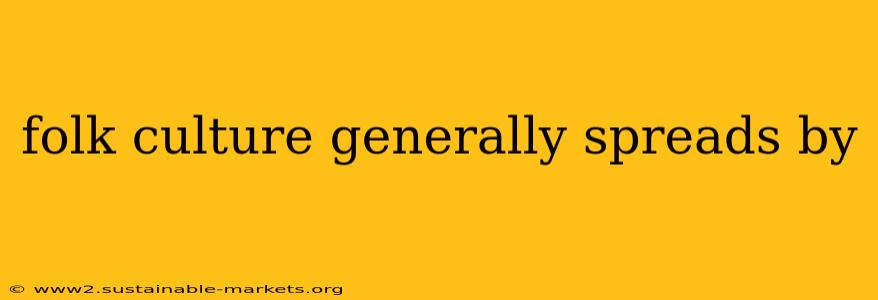Folk culture, encompassing traditions, customs, and beliefs passed down through generations, doesn't spread like wildfire through mass media. Instead, its transmission is a slower, more organic process, primarily driven by direct, personal contact and proximity. This contrasts sharply with the rapid dissemination of popular culture. Let's delve into the key mechanisms:
Key Mechanisms of Folk Culture Spread
Several factors influence how folk culture diffuses across populations and regions:
1. Relocation Diffusion: The Movement of People
This is arguably the most significant factor. When people migrate, they carry their cultural practices, beliefs, and traditions with them. This includes everything from culinary techniques and musical styles to storytelling traditions and religious practices. Think of immigrant communities establishing themselves in new lands and maintaining—and often adapting—their cultural heritage. This is relocation diffusion in action.
2. Expansion Diffusion: Growth Within a Population
While relocation diffusion involves physical movement, expansion diffusion sees the spread of folk culture within a population. This happens in a few ways:
-
Contagious Diffusion: This is a relatively uniform spread, like ripples in a pond. It happens through direct contact between individuals, often within close-knit communities. Learning traditional crafts, songs, or dances from family members or community elders is a prime example of contagious diffusion.
-
Hierarchical Diffusion: This type of diffusion involves the spread of cultural elements from influential centers or figures to less influential areas. For example, a renowned artisan's technique might spread from a major city to smaller villages, or a popular folk song might diffuse from a prominent musician to local performers.
-
Stimulus Diffusion: This refers to the adoption of an underlying idea or principle of a cultural element, rather than the element itself. Imagine a community adopting the concept of a particular type of pottery, but adapting the techniques and designs to their own aesthetic preferences.
3. The Role of Social Networks and Interconnectedness
Folk cultures thrive in communities with strong social ties. Shared experiences, rituals, and celebrations reinforce and transmit cultural practices. These social networks, both physical and increasingly digital, act as conduits for the diffusion of folk traditions. The internet, while often associated with popular culture, can also play a role in preserving and spreading niche folk cultures. However, the intimate and personal nature of the transmission remains central.
4. Barriers to Diffusion: Resistance and Change
It's important to acknowledge that folk culture isn't passively absorbed; it faces obstacles:
-
Cultural Resistance: Communities often resist the adoption of external cultural elements that they perceive as threatening to their identity.
-
Globalization's Impact: The rise of globalization and popular culture poses a significant challenge to the survival of some folk cultures. However, paradoxically, globalization can also lead to increased awareness and appreciation of lesser-known folk traditions worldwide.
-
Acculturation and Adaptation: Folk cultures are rarely static. They constantly evolve and adapt as they encounter new influences and contexts. This dynamic process leads to hybridization, the blending of different cultural elements.
In conclusion, the spread of folk culture is a complex process involving a combination of movement, contact, social networks, and adaptation. While it differs vastly from the rapid dissemination of popular culture, it persists, evolves, and continues to enrich the tapestry of human experience.

